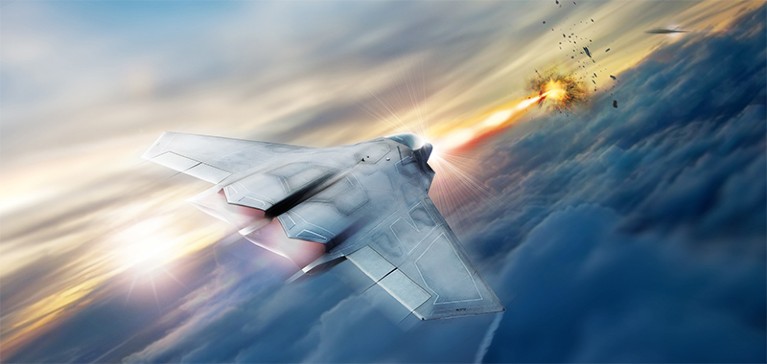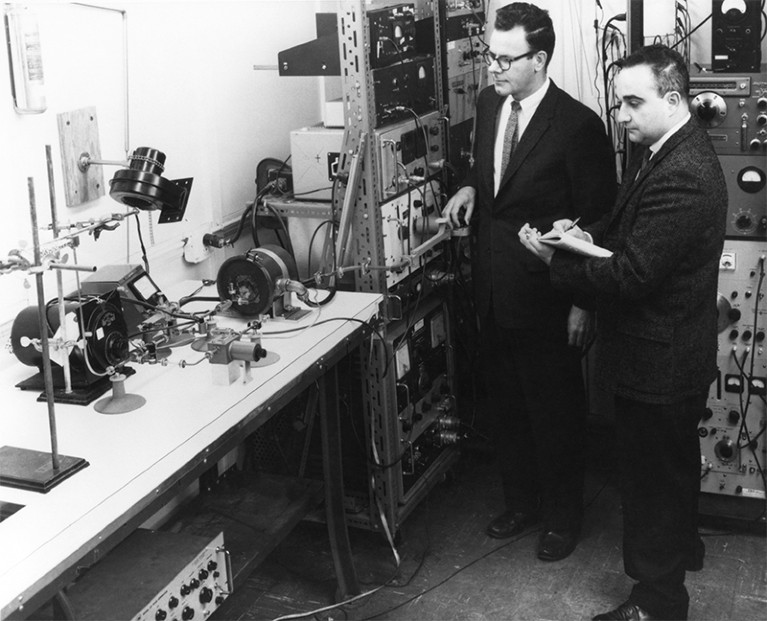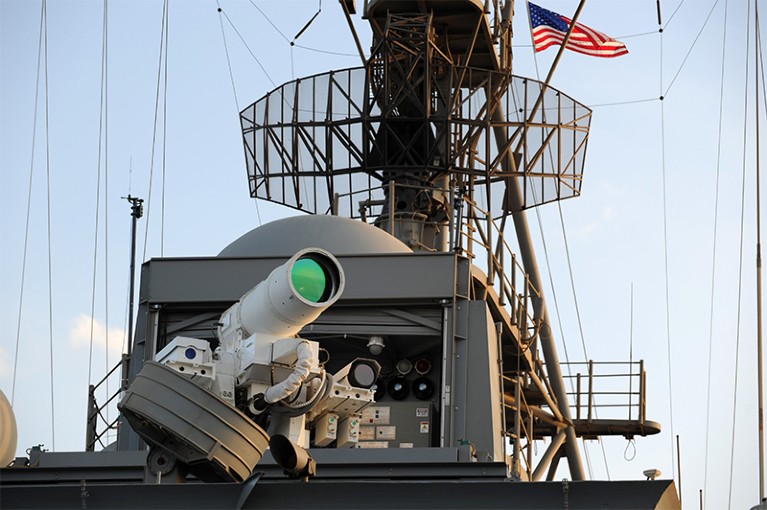
An artist’s impression of a high-energy laser in use on a US Airforce fighter jet.Credit: Nicholas Violoa/Infoscitex/USAFRL
Lasers, Death Rays, and the Long, Strange Quest for the Ultimate Weapon Jeff Hecht Prometheus (2019)
Lasers first emerged nearly 60 years ago, but the idea of using powerful beams of heat or light is hardly new. In the third century bc, for instance, Greek scientist Archimedes allegedly used mirrors reflecting the Sun’s rays to attack Roman ships off Sicily. Millennia later, ‘death rays’ — concentrated light or electricity — became a science-fiction trope, from H. G. Wells’s 1898 The War of the Worlds to the Star Wars franchise.
As often happens, futurist fiction sparked the real thing. And that’s the story told in Lasers, Death Rays, and the Long, Strange Quest for the Ultimate Weapon.
As the title indicates, Jeff Hecht’s book is not about the mundane, ubiquitous lasers of supermarket checkouts and CD players. Hecht, a science writer who has covered lasers since the 1970s, instead records efforts to adapt the technology for military use. In 1934, for instance, inventor Nikola Tesla — instrumental in developing the alternating-current electricity system — announced that he had attempted to design a device that would send a ‘death beam’ of concentrated particles to detect and destroy submarines. As Hecht relates, US government agents looked into the proposal after Tesla’s death, but reviewer John G. Trump, an electrical engineer (and uncle of the current US president), declared it too speculative.
The United States was hardly alone in its fervour for a death ray. Before the Second World War, the British air ministry offered a bounty of £1,000 (more than £60,000 (US$76,000) today) to anyone who could craft and demonstrate a ‘ray weapon’ that could kill a sheep at 100 metres. (This was ambitious: by the end of the Second World War, the Japanese military could still only kill rabbits at 30 metres using microwave tubes.) By the 1950s, a new invention was about to focus minds.
The laser, as Hecht makes clear, was a technology intertwined with politics. The star figure is physicist Gordon Gould. In the late 1950s, Gould explored using light to optically ‘pump’ a maser — a device emitting microwaves at a specific frequency, invented by physicist Charles Townes in 1953. This was, in essence, the first conceptualization of a laser, which works when electrons in a medium (often a gas or crystal) absorb energy from light or electricity, become ‘excited’ and decay. The result is an intense beam of collimated, or parallel, rays of electromagnetic radiation.

Gordon Gould (left, with Ben Senitsky) experimented with microwave lasers in the 1950s.Credit: ESVA/AIP/SPL
Gould’s progress towards the real thing, however, was impeded by troubles with patents and politics. In the late 1950s, he pitched the concept of powerful ray guns using lasers to the US defence department’s Advanced Research Projects Agency (ARPA, the predecessor to today’s DARPA), which developed military technologies. The agency invested heavily, but Gould’s history as a former member of the Communist Party USA caught up with him: ARPA made the project classified, then denied him clearance. It was physicist Theodore Maiman of the Hughes Research Laboratories who first demonstrated a laser, in Malibu, California, in 1960. Maiman also got the patent and a paper in Nature (T. H. Maiman Nature 187, 493–494; 1960). Gould, after significant battles, did manage to secure important early patents himself.
War machine
Hecht tours the most powerful lasers imaginable. These range from 1960s ‘rocket-engine’ lasers that emitted light by burning hot gases, to physicist Edward Teller’s 1970s idea of weaponizing X-rays emitted from nuclear bombs. The Pentagon kept investing massively, particularly in lasers that could hit airborne targets such as missiles. Getting the laser system itself airborne was the real challenge, however.
US president Ronald Reagan is a central figure in this story. Hecht notes an odd echo between his years as a Hollywood actor and his tenure in the White House. In 1940, Reagan starred in Murder in the Air as an agent trying to destroy an aeroplane-mounted ray weapon that could disable engines. In the 1980s, while in office, he announced the Strategic Defense Initiative to disable actual nuclear missiles. Inspired by some of Teller’s ideas, one proposal was a space-based laser system to disarm missiles, explored after Reagan’s notorious 1983 ‘Star Wars’ speech. (President Donald Trump is not the first to explore a ‘space force’.)
After the end of the cold war, Hecht relates how the focus shifted back to laser-based weaponry for use in the atmosphere. In 2008, the US Air Force, using a Boeing 747 aeroplane, adaptive optics and more than $4.3 billion in funding, fired the first shots of such a terrifying system. Despite its success, the programme was discontinued in 2011, with $5 billion already spent.

A laser cannon mounted on a US Navy staging base for demonstration.Credit: John F. Williams/US Navy
Smaller-scale military applications also feature, as do solid-state lasers. These use a solid ‘host’: optical fibres with traces of dopants such as rare-earth elements, or the interface between two semiconductor materials. They are so precise that they can slice through communication lines or disable small drones. Hecht touches, too, on the next generation of high-powered lasers. One promising candidate exploits vapours of alkali metals such as potassium, which allows conversion of almost all the energy used to excite the electrons, without heating problems. Ironically, alkali-metal lasers were an early project that the Pentagon left unclassified — so Gould could work on it without security clearance.
Hecht’s decades-long immersion in the topic gives his narrative an insiders’ edge. In the 1970s, for instance, he worked for the magazine Laser Focus. Although this mainly concentrated on research applications — such as using laser light at different frequencies to study the properties of atoms — it inevitably covered stories that would find uses in laser weapons. The cover of the December 1974 issue featured a mirror that could adjust its shape to change how it reflected light; in the 2000s, the US Air Force deployed the technology for its giant flying laser programme.
Lasers, Death Rays, and the Long, Strange Quest for the Ultimate Weapon is not an easy story to tell, given the vast cast of scientists, myriad technologies and grim purpose. It does, however, capture the adventures and misadventures of big laser development from an important perspective for our times. Beyond the intriguing details of tomorrow’s technologies, there lies a pressing question: will future political leaders be more interested in defence than attack?

 Beyond pulp: trailblazers of science fiction’s golden age
Beyond pulp: trailblazers of science fiction’s golden age
 Microwave weapons: Wasted energy
Microwave weapons: Wasted energy
 How the change agent has changed
How the change agent has changed





